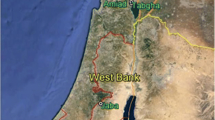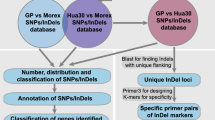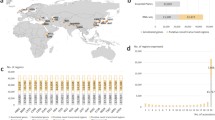Abstract
Barley (Hordeum vulgare L.) is the fourth largest cereal crop in the world with extensive adaptability in diverse environments. There is increasing evidence that epigenetics contributes to plant evolution and adaptation. However, epigenetic variation in barley and their correlations with genetic variation remains largely unknown. In this study, we investigated epigenetic and genetic diversity in 48 Tibetan wild distribution (TWD) barley accessions, 24 Chinese cultivars (CC), and 24 foreign cultivars (FC) using DNA methylation-sensitive amplified polymorphism and simple sequence repeats. We found a relatively high level of epigenetic (I = 0.639 and h = 0.450) and genetic (I = 0.637 and h = 0.446) diversity in barley, and a significant correlation between epigenetic and genetic variation in barley (R2 = 0.160, P < 0.001). No differences in genetic variation were observed among TWD, CC and FC populations. However, the TWD population had significantly higher epigenetic diversity (I = 0.607 and h = 0.424, P < 0.001) than both cultivated populations (FC: I = 0.584 and h = 0.402; CC: I = 0.544 and h = 0.372). Also, the TWD population had significantly higher average hemi-methylation (20.35%) and full-methylation (25.37%) levels than both cultivated populations (FC: 16.13% and 20.98%, respectively; CC: 15.98% and 18.95%, respectively). This study has provided valuable information on DNA methylation variation across diverse barley accessions and indicated that epigenetic variations might be another factor contributing to barley diversity.




Similar content being viewed by others
References
Alakärppä E, Salo HM, Valledor L, Cañal MJ, Häggman H, Vuosku J (2018) Natural variation of DNA methylation and gene expression may determine local adaptations of Scots pine populations. J Exp Bot 69:5293–5305. https://doi.org/10.1093/jxb/ery292
Alonso C, Pérez R, Bazaga P, Medrano M, Herrera CM (2016) MSAP markers and global cytosine methylation in plants: a literature survey and comparative analysis for a wild-growing species. Mol Ecol Resour 16:80–90. https://doi.org/10.1111/1755-0998.12426
Avramidou EV, Ganopoulos IV, Doulis AG, Tsaftaris AS, Aravanopoulos FA (2015) Beyond population genetics: natural epigenetic variation in wild cherry (Prunus avium). Tree Genet Genomes 11:95. https://doi.org/10.1007/s11295-015-0921-7
Dai F, Nevo E, Wu DZ, Comadran J, Zhou MX, Qiu L, Chen ZH, Beiles A, Chen GX, Zhang GP (2012) Tibet is one of the centers of domestication of cultivated barley. Proc Natl Acad Sci USA 109:16969–16973. https://doi.org/10.1073/pnas.1215265109
Dawson IK, Russell J, Powell W, Steffenson B, Thomas WT, Waugh R (2015) Barley: a translational model for adaptation to climate change. New Phytol 206:913–931. https://doi.org/10.1111/nph.13266
Earl DA, Vonholdt BM (2012) STRUCTURE HARVESTER: a website and program for visualizing STRUCTURE output and implementing the Evanno method. Conserv Genet Resour 4:359–361. https://doi.org/10.1007/s12686-011-9548-7
El-Esawi MA, Alaraidh IA, Alsahli AA, Ali HM, Alayafi AA, Witczak J, Ahmad M (2018) Genetic variation and alleviation of salinity stress in barley (Hordeum vulgare L.). Molecules 23:2488. https://doi.org/10.3390/molecules23102488
Feng SH, Jacobsen SE (2011) Epigenetic modifications in plants: an evolutionary perspective. Curr Opin Plant Biol 14:179–186. https://doi.org/10.1016/j.pbi.2010.12.002
Fu YB, Peterson GW (2011) Genetic diversity analysis with 454 pyrosequencing and genomic reduction confirmed the eastern and western division in the cultivated barley gene pool. Plant Genome 4:226–237. https://doi.org/10.3835/plantgenome2011.08.0022
Gong X, Westcott S, Li C, Yan G, Lance R, Sun D (2009) Comparative analysis of genetic diversity between Qinghai-Tibetan wild and Chinese landrace barley. Genome 52:849–861. https://doi.org/10.1139/G09-058
Groot MP, Wagemaker N, Ouborg NJ, Verhoeven KJ, Vergeer P (2018) Epigenetic population differentiation in field-and common garden-grown Scabiosa columbaria plants. Ecol Evol 8:3505–3517. https://doi.org/10.1002/ece3.3931
Guo WL, Hussain N, Wu R, Liu B (2018) High hypomethylation and epigenetic variation in fragmented populations of wild barley (Hordeum brevisubulatum). Pak J Bot 50:1379–1386
Henderson IR, Salt DE (2017) Natural genetic variation and hybridization in plants. J Exp Bot 68:5415–5417. https://doi.org/10.1093/jxb/erx377
Hill CB, Angessa TT, McFawn LA, Wong D, Tibbits J, Zhang XQ, Forrest K, Moody D, Telfer P, Westcott S, Diepeveen D, Xu YH, Tan C, Hayden M, Li C (2019) Hybridisation-based target enrichment of phenology genes to dissect the genetic basis of yield and adaptation in barley. Plant Biotechnol J 17:932–944. https://doi.org/10.1111/pbi.13029
Hua W, Zhang XQ, Zhu JH, Shang Y, Wang JM, Jia QJ, Li CD, Yang JM (2015) A study of genetic diversity of colored barley (Hordeum vulgare L.) using SSR markers. Genet Resour Crop Evol 62:395–406. https://doi.org/10.1007/s10722-014-0165-7
Kawakatsu T, Huang SSC, Jupe F, Sasaki E, Schmitz RJ, Urich MA, Castanon R, Nery JR, Barragan C, He Y, Chen H, Dubin M, Lee CR, Wang CM, Bemm F, Becker C, O’Neil R, O’Malley RC, Quarless DX, Consortium TG, Schork NJ, Weigel D, Nordborg M, Ecker JR (2016) Epigenomic diversity in a global collection of Arabidopsis thaliana accessions. Cell 166:492–505. Doi:10.1016/j.cell.2016.06.044
Kooke R, Johannes F, Wardenaar R, Becker F, Etcheverry M, Colot V, Vreugdenhil D, Keurentjes JJB (2015) Epigenetic basis of morphological variation and phenotypic plasticity in Arabidopsis thaliana. Plant Cell 27:337–348. https://doi.org/10.1105/tpc.114.133025
Kumar S, Stecher G, Tamura K (2016) MEGA7: molecular evolutionary genetics analysis version 7.0 for bigger datasets. Mol Biol Evol 33:1870–1874. https://doi.org/10.1093/molbev/msw054
Latzel V, Allan E, Silveira AB, Colot V, Fischer M, Bossdorf O (2013) Epigenetic diversity increases the productivity and stability of plant populations. Nat Commun 4:2875. https://doi.org/10.1038/ncomms3875
Li MR, Shi FX, Zhou YX, Li YL, Wang XF, Zhang C, Wang XT, Liu B, Xiao HX, Li LF (2015) Genetic and epigenetic diversities shed light on domestication of cultivated ginseng (Panax ginseng). Mol Plant 8:1612–1622. https://doi.org/10.1016/j.molp.2015.07.011
Lira-Medeiros CF, Parisod C, Fernandes RA, Mata CS, Cardoso MA, Ferreira PCG (2010) Epigenetic variation in mangrove plants occurring in contrasting natural environment. PLoS ONE 5:e10326. https://doi.org/10.1371/journal.pone.0010326
Liu LL, Du N, Pei CP, Guo X, Guo WH (2018) Genetic and epigenetic variations associated with adaptation to heterogeneous habitat conditions in a deciduous shrub. Ecol Evol 8:2594–2606. https://doi.org/10.1002/ece3.3868
Ma KF, Sun LD, Cheng TR, Pan HT, Wang J, Zhang QX (2018) Epigenetic variance, performing cooperative structure with genetics, is associated with leaf shape traits in widely distributed populations of ornamental tree Prunus mume. Front Plant Sci 9:41. https://doi.org/10.3389/fpls.2018.00041
Mascher M, Gundlach H, Himmelbach A, Beier S, Twardziok SO, Wicker T, Radchuk V, Dockter C, Hedley PE, Russell J, Bayer M, Ramsay L, Liu H, Haberer G, Zhang XQ, Zhang QS, Barrero RA, Li L, Taudien S, Groth M, Felder M, Hastie A, Šimková H, Staňková H, Vrána J, Chan S, Muñoz-Amatriaín M, Ounit R, Wanamaker S, Bolser D, Colmsee C, Schmutzer T, Aliyeva-Schnorr L, Grasso S, Tanskanen J, Chailyan A, Sampath D, Heavens D, Clissold L, Cao S, Chapman B, Dai F, Han Y, Li H, Li X, Lin CY, McCooke JK, Tan C, Wang PH, Wang SB, Yin SY, Zhou GF, Poland JA, Bellgard Matthew I, Borisjuk L, Houben A, Doležel J, Ayling S, Lonardi S, Kersey P, Langridge P, Muehlbauer GJ, Clark MD, Caccamo M, Schulman AH, Mayer KFX, Platzer M, Close TJ, Scholz U, Hansson M, Zhang GP, Braumann L, Spannagl M, Li CD, Waugh R, Stein N (2017) A chromosome conformation capture ordered sequence of the barley genome. Nature 544:427–433. https://doi.org/10.1038/nature22043
Morrell PL, Clegg MT (2007) Genetic evidence for a second domestication of barley (Hordeum vulgare) east of the Fertile Crescent. Proc Natl Acad Sci USA 104:3289–3294. https://doi.org/10.1073/pnas.0611377104
Morrell PL, Gonzales AM, Meyer KK, Clegg MT (2013) Resequencing data indicate a modest effect of domestication on diversity in barley: a cultigen with multiple origins. J Hered 105:253–264. https://doi.org/10.1093/jhered/est083
Peakall R, Smouse PE (2012) GenAlEx 6.5: genetic analysis in Excel. Population genetic software for teaching and research—an update. Bioinformatics 28:2537–2539. https://doi.org/10.1093/bioinformatics/bts460
Pritchard JK, Stephens M, Donnelly P (2000) Inference of population structure using multilocus genotype data. Genetics 155:945–959
R Core Team (2013) R: A language and environment for statistical computing. R Foundation for statistical computing, Vienna, Austria. http://www.R- project.org/
Richards CL, Alonso C, Becker C, Bossdorf O, Bucher E, Colomé-Tatché M, Durka W, Engelhardt J, Gaspar B, Gogol-Döring A (2017) Ecological plant epigenetics: evidence from model and non-model species, and the way forward. Ecol Lett 20:1576–1590. https://doi.org/10.1111/ele.12858
Roy N, Choi JY, Lim MJ, Lee SI, Choi HJ, Kim NS (2015) Genetic and epigenetic diversity among dent, waxy, and sweet corns. Genes Genom 37:865–874. https://doi.org/10.1007/s13258-015-0329-7
Russell J, Mascher M, Dawson IK, Kyriakidis S, Calixto C, Freund F, Bayer M, Milne I, Marshall-Griffiths T, Heinen S, Hofstad A, Sharma R, Himmelbach A (2016) Exome sequencing of geographically diverse barley landraces and wild relatives gives insights into environmental adaptation. Nat Genet 48:1024. https://doi.org/10.1038/ng.3612
Schulz B, Eckstein RL, Durka W (2013) Scoring and analysis of methylation-sensitive amplification polymorphisms for epigenetic population studies. Mol Ecol Resour 13:642–653. https://doi.org/10.1111/1755-0998.12100
Schulz B, Eckstein RL, Durka W (2014) Epigenetic variation reflects dynamic habitat conditions in a rare floodplain herb. Mol Ecol 23:3523–3537. https://doi.org/10.1111/mec.12835
Storchova H, Hrdlickova R, Chrtek J Jr, Tetera M, Fitze D, Fehrer J (2000) An improved method of DNA isolation from plants collected in the field and conserved in saturated NaCl/CTAB solution. Taxon 49:79–84. https://doi.org/10.2307/1223934
Takata M, Kishima Y, Sano Y (2005) DNA methylation polymorphisms in rice and wild rice strains: detection of epigenetic markers. Breed Sci 55:57–63. https://doi.org/10.1270/jsbbs.55.57
Vuylsteke M, Peleman JD, Van Eijk MJ (2007) AFLP-based transcript profiling (cDNA-AFLP) for genome-wide expression analysis. Nat Protoc 2:1399–1413. https://doi.org/10.1038/nprot.2007.174
Wang YG, Ren XF, Sun DF, Sun GL (2015) Origin of worldwide cultivated barley revealed by NAM-1 gene and grain protein content. Front Plant Sci 6:803. https://doi.org/10.3389/fpls.2015.00803
Wang MZ, Li HL, Li JM, Yu FH (2019) Correlations between genetic, epigenetic and phenotypic variation of an introduced clonal herb. Heredity 124:146–155. https://doi.org/10.1038/s41437-019-0261-8
Xia H, Huang WX, Xiong J, Tao T, Zheng XG, Wei HB, Yue YX, Chen L, Luo LJ (2016) Adaptive epigenetic differentiation between upland and lowland rice ecotypes revealed by methylation-sensitive amplified polymorphism. PLoS ONE 11:e0157810. https://doi.org/10.1371/journal.pone.0157810
Xie HH, Konate M, Sai N, Tesfamicael KG, Cavagnaro T, Gilliham M, Breen J, Metcalfe A, Stephen JR, De Bei R, Collins C, Lopez CMR (2017) Global DNA methylation patterns can play a role in defining terroir in grapevine (Vitis vinifera cv. Shiraz). Front Plant Sci 8:1860. https://doi.org/10.3389/fpls.2017.01860
Xu YH, Zhong L, Wu XM, Fang XP, Wang JB (2009) Rapid alterations of gene expression and cytosine methylation in newly synthesized Brassica napus allopolyploids. Planta 229:471–483. https://doi.org/10.1007/s00425-008-0844-8
Xu YH, Jia QJ, Zhou GF, Zhang XQ, Angessa T, Broughton S, Yan G, Zhang WY, Li CD (2017) Characterization of the sdw1 semi-dwarf gene in barley. BMC Plant Biol 17:11. https://doi.org/10.1186/s12870-016-0964-4
Xu J, Chen G, Hermanson PJ, Xu Q, Sun C, Chen W, Kan Q, Li M, Crisp PA, Yan J, Li L, Springer NM, Li Q (2019) Population-level analysis reveals the widespread occurrence and phenotypic consequence of DNA methylation variation not tagged by genetic variation in maize. Genome Biol 20:243. https://doi.org/10.1186/s13059-019-1859-0
Zeng XQ, Guo Y, Xu QJ, Mascher M, Guo GG, Li SC, Lk Mao, Liu QF, Xia ZF, Zhou JH, Yuan HJ, Tai SS, Wang YL, Wei ZX, Song L, Zha S, Li SM, Tang YW, Bai LJ, Zhuang ZH, He WM, Zhao SC, Fang XD, Gao Q, Yin Y, Wang J, Yang HM, Zhang J, Henry RJ, Stein N, Tashi N (2018) Origin and evolution of qingke barley in Tibet. Nat Commun 9:5433. https://doi.org/10.1038/s41467-018-07920-5
Zhang XC, Fan Y, Shabala S, Koutoulis A, Shabala L, Johnson P, Hu HL, Zhou MX (2017) A new major-effect QTL for waterlogging tolerance in wild barley (H. spontaneum). Theor Appl Genet 130:1559–1568. https://doi.org/10.1007/s00122-017-2910-8
Acknowledgements
We are grateful to Prof. Ying Ding from the College of Life Sciences, Wuhan University, for providing Tibetan wild distribution barley accessions.
Funding
The project funds were provided by the National Natural Science Foundation of China (31501309, 31201212) and National Key R&D Program of China (2016YFD0102101).
Author information
Authors and Affiliations
Contributions
YX and CL designed the experiments; BL, QG, WH, WZ, and GC conducted the research; YX and BL performed the statistical analyses; BL, XY, and CL wrote and finalized the manuscript.
Corresponding authors
Ethics declarations
Conflict of interest
The authors declare that the research was conducted in the absence of any commercial or financial relationships that could be construed as a potential conflict of interest.
Ethical approval
This article does not contain any studies with human participants or animals performed by any of the authors.
Additional information
Publisher's Note
Springer Nature remains neutral with regard to jurisdictional claims in published maps and institutional affiliations.
Electronic supplementary material
Below is the link to the electronic supplementary material.
10722_2020_1019_MOESM3_ESM.tif
Supplementary Fig. 1 Partial SSR molecular bands generated with Chr5-Ind5026 and monitored by capillary gel electrophoresis. W: TWD individuals, F: FC individuals, C: CC individuals (TIFF 492 kb)
10722_2020_1019_MOESM4_ESM.tif
Supplementary Fig. 2 Partial MSAP bands monitored by capillary gel electrophoresis. MSAP markers generated with the selected primer combinations of BstYI-C + TAA/HpaII/MspI (a) + AT and BstYI-T + TGC/HpaII/MspI + TCAA (b). H and M represent genomic DNA sample digested by BstYI/HpaII and BstYI/MspI, respectively (TIFF 3013 kb)
Rights and permissions
About this article
Cite this article
Li, B., Gong, Q., Hua, W. et al. Genetic and epigenetic variations in barley (Hordeum vulgare L.) using SSR and MSAP approaches. Genet Resour Crop Evol 68, 729–739 (2021). https://doi.org/10.1007/s10722-020-01019-x
Received:
Accepted:
Published:
Issue Date:
DOI: https://doi.org/10.1007/s10722-020-01019-x




